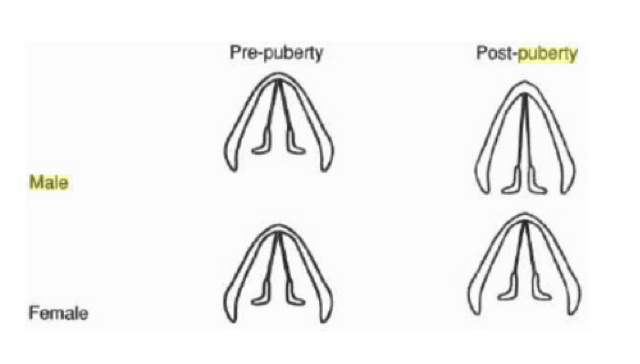The Adolescent Voice
The Adolescent ~PART 1
There are physiological and structural differences that occur in the voice during prepubescent and puberty. Understanding how and why these changes happen are useful in understanding the difficulties encountered by the young male and female vocalists.
Puberty and adolescence:
Until puberty, the larynx is of equal size in both male and females. At puberty the male laryngeal growth outdistances the female in the anteroposterior dimensions.
On the on set of puberty and during the period from 10 to 14 years, there is a dramatic period of general growth associated with the increased secretion of androgens in the male and oestrogens in the female. As the hormonal changes take place, male and female secondary sexual characteristics emerge.
The dimensions of the vocal tract reflect this period of growth and differences between males and females. Laryngeal dimensions in the male are generally larger and the thyroid cartilage changes its configuration. In Prepubescent the angel of the thyroid cartilage is 120 degrees in both female and males. During pubertal change in the male, the thyroid cartilage enlarges significantly and the angel decreases to 90 degrees, giving rise to the marked thyroid prominence known as the Adam’s apple. Increase in length of the thyroid cartilage is nearly three times greater in males than in females.
The vertical descent of the larynx during life. The illustration demonstrates the relationship of the lower border of the cricoid cartilage to the cervical vertebrae at various stages.
At birth, the lower border of the cricoid cartilage is level between cervical vertebrae 3 and 4 (C3 and C4). By age 5, the laynx has descended almost to the level of C7. Between ages 15 to 20, it remains at C7.
Vocal Folds
Before puberty, the vocal folds of boys and girls are the same size. While male’s vocal cords grow dramatically, female’s vocal cords only increase slightly.
The increased size of the laryngeal skeleton is reflected in the length of the vocal folds. In girls, the mean length of the vocal folds is 15 mm before puberty and this may increase to 17 mm in a contralto.
During the mutation period, a boys vocal folds double in length and may increase to a maximum of 23 mm in the bass voice. The minimum vocal fold length for the male is 17 mm, it can be seen that a tenor and a contralto may have much the same pitch range, but it is the larger resonators of the larynx, pharynx and the chest that distinguish the male from the female voice.
Hormones have been linked to voice changes in adolescents and adults. In puberphonia, the male adolenscent voice has a higher pitch than is typical of other males of the same age. This voice disorder is related to emotional stress, which results from psychosocial changes that occur during puberty. Conversion aphonia and persistent falsetto (puberphonia) are two functional voice disorders. In conversion or functional aphonia, there may be lack of vocal fold adduction during attempted phonation.
Above are the laryngeal changes at puberty and the transverse section of the larynx.
Dimensions of the larynx
The membranes and the cartilagionous portions of the vocal folds are equal in length in infancy creating a proportionately larger glottis. By adulthood the membranes portion with greater pliability has elongated to approximately two thirds of the total glottal length. Glottal width and infraglottal dimensions increase with age.
Ingo Titze, points out that examination of laryngeal differences;
With regard to gender reveals; the vocal fold length is significantly greater in the pubertal male then in the pubertal female. The vocal folds of the adult male are approximately thirty percent lager then those of the adult female."



